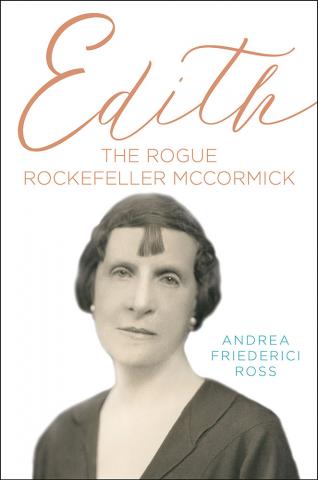By SIU Press
“This thrilling story of a daughter of America’s foremost industrialist, John D. Rockefeller, is complete with sex, money, mental illness, and opera divas – and a woman who strove for the independence to make her own choices. Rejecting the limited gender role carved out for her by her father and society, Edith Rockefeller McCormick forged her own path, despite pushback from her family and ultimate financial ruin,” SIU Press says.

“Young Edith and her siblings had access to the best educators in the world, but the girls were not taught how to handle the family money; that responsibility was reserved for their younger brother.
“A parsimonious upbringing did little to prepare Edith for life after marriage to Harold McCormick, son of the Reaper King Cyrus McCormick. The rich young couple spent lavishly. They purchased treasures like the jewels of Catherine the Great, entertained in grand style in a Chicago mansion, and contributed to the city’s cultural uplift, founding the Chicago Grand Opera. They supported free health care for the poor, founding and supporting the John R. McCormick Memorial Institute for Infectious Diseases. Later, Edith donated land for what would become Brookfield Zoo.
“Though she lived a seemingly enviable life, Edith’s disposition was ill-suited for the mores of the time. Societal and personal issues – not least of which were the deaths of two of her five children – caused Edith to experience phobias and panic attacks. Dissatisfied with rest cures, she ignored her father’s expectations, moved her family to Zurich, and embarked on a journey of education and self-examination. Edith pursued analysis with then-unknown Carl Jung. Her generosity of spirit led Edith to become Jung’s leading patron. She also supported up-and-coming musicians, artists, and writers, including James Joyce as he wrote Ulysses.
“While Edith became a Jungian analyst, her husband, Harold, pursued an affair with an opera star. After returning to Chicago and divorcing Harold, Edith continued to deplete her fortune. She hoped to create something of lasting value, such as a utopian community and affordable homes for the middle class. Edith’s goals caused further difficulties in her relationship with her father and are why he and her brother cut her off from the family funds even after the 1929 stock market crash ruined her. Edith’s death from breast cancer three years later was mourned by thousands of Chicagoans.”
–
Via Wikipedia:
“On November 26, 1895, she married Harold Fowler McCormick from Chicago, a son of Nancy Fowler and Cyrus Hall McCormick, the inventor of the mechanical reaper.
“The married couple spent their first two years living in Council Bluffs, Iowa, where Harold managed a branch of his father’s business. They later moved to Chicago.
“In 1912, they hired prominent architect Charles A. Platt to build a mansion on their large country estate, located directly on Lake Michigan in Lake Forest, Illinois, which they named Villa Turicum, and which had extensive architecturally landscaped gardens.”
*
“Edith helped fund the juvenile probation program of Chicago’s pioneering Juvenile Court system when it was revealed that, although legislation set up the system, there was no provision to fund the probation officers.
“Edith began support of the Art Institute in 1909 as a charter member and supported it with monetary contributions and loans from her extensive personal art collection.
“She and Harold, along with other wealthy patrons, founded the Grand Opera Company, the first in Chicago, in 1909 . . .
“In 1919. McCormick donated land she had received from her father as a wedding gift to the Forest Preserve of Cook County, to be developed as a zoological garden, later to become Chicago’s Brookfield Zoo.”
*
“In 1925, she and other wealthy Chicago women including Miss Helen M. Bennett, Mrs. John V. Farwell, Mrs. Silas Strawn, Mrs. John Alden Carpenter, Mrs. B.F. Langworthy, Mrs. Florence Fifer Bohrer, and Mrs. Medill McCormick sponsored an international exposition to celebrate the progress and achievements of American women – the first Woman’s World’s Fair, which was held at the American Exposition Palace on Lake Michigan in April 1925, and was held again each year in Chicago in April or May from 1926 to 1928.”
–
See also: Edith Rockefeller McCormick Reigned As A Queen Of Chicago’s Elite – And As A Quirky Visionary.
–
Comments welcome.
Posted on August 19, 2020


